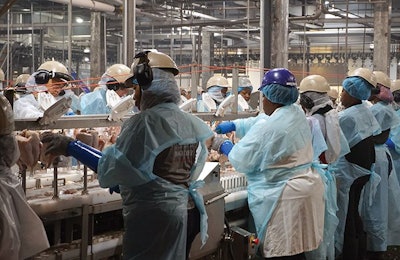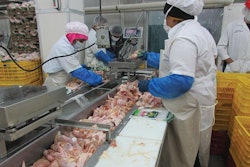
Poultry plants operating on the New Poultry Inspection System (NPIS) can now operate at speeds as high as 175 birds per minute, but speeding up requires a complex federal approval process.
Brandon Prestridge, Wayne Farms LLC’s supplier quality and process improvement manager, said the Oakwood, Georgia, integrated poultry company was recently granted what is called a line speed waiver as part of its participation in the New Poultry Inspection System. He gave advice for pursuing a faster line speed as part of the 2019 Poultry Processor Workshop. The event was presented by the U.S. Poultry & Egg Association. Prestridge spoke on May 22.

Brandon Prestridge, Wayne Farms | Photo by Austin Alonzo
Introduction to the line speed waiver
The NPIS was introduced in 2014 as a plan to allow poultry plants to replace U.S. Department of Agriculture (USDA) evisceration line inspectors with their own employees. However, Prestridge said, interest in the program was low because plant operators weren’t seeing much of an advantage to switching. After being lobbied by the industry, the USDA reintroduced the concept of a line speed waiver that would allow NPIS plants to operate faster under certain conditions.
Wayne, the seventh-largest integrator in the U.S., according to WATT Global Media’s Top Broiler Company rankings, began transitioning all of its processing plants to the NPIS in 2018. In Spring 2019, the company’s Dothan, Alabama, plant was granted a line speed waiver by the USDA's Food Safety and Inspection Service (FSIS) to increase its speed to 175 birds per minute from 140 birds per minute (BPM), according to the FSIS.
How to apply for a waiver
Before obtaining a line speed waiver, plants must be on the NPIS for a year. Getting into the program requires filing an application with the USDA as well as implementation of new processes and new employee training.
A letter of intent must be submitted to the local branch of the USDA 90 days in advance of a switch. Some districts require as much as six months advance notice, however, to allocate the necessary training resources. Getting employees ready to assume the sorting and inspecting duties is an involved task, Prestridge said, but the USDA does provide valuable resources to make training easier.
What goes in the application letter?
Prestridge said the application letter for a waiver should be sent in a month before the anniversary date. That letter needs to be detailed so regulators can understand the operation. It needs to cover the plant’s lines, process flow, statistics about how many birds are processed on a weekly basis and what Salmonella category the plant currently occupies. Plants in category three cannot receive a waiver.
Proving food safety standards: Thoroughly cover a plant's antimicrobial interventions and explain what indicator organism is, and will be, used as part of the FSIS Salmonella Initiative Program (SIP). The letter must show the plant is capable of producing birds at the ready-to-cook poultry standard both now and at the higher line speed.
Data must be placed in the application reflecting performance before the move to NPIS and after the switch. Going forward, data should be kept to be shown to FSIS after the waiver is granted. Furthermore, the hazard analysis and critical control points (HACCP) plan must be updated to show a faster line speed won’t hurt food safety, either.
Worker safety: Show regulators that moving to 175 BPM will not endanger USDA inspectors nor plant employees working as sorters.
Animal welfare: Explain what will be done to prevent any loss of welfare, such as adding additional employees hanging birds, lengthening the stunner or increasing the bleed out time. He recommended getting a letter from the manufacturer of the slaughter machinery supporting the argument that a faster line speed won’t harm animal welfare and, in addition, stating all of the plant machinery will continued work effectively at 175 BPM.
Maintain eligibility: Prove the plant can maintain food safety, Salmonella and ready-to-cook chicken standards before, during and after increasing line speed. Essentially, regulators need to know everything in the plant is going to work as well as it did before increasing line speed and they need documentation to back it up.

Protecting food safety, worker safety and animal welfare is necessary to gaining and keeping a line speed waiver. | Photo by Austin Alonzo
After approval
If an application is submitted and approved, it does not mean it’s time for the plant to crank up the line speed to 175 BPM.
The approval letter from the USDA will include two attachments: a poultry sampling template and a line speed waiver verification plan. These documents will track the plant’s ability to maintain operating standards at a higher line speed.
Prestridge said plants are asked to take a paired data sample for aerobic plate counts (APC) and one paired sample for Salmonella from both rehang and post-chill on a weekly basis.
The poultry sampling template is an excel spreadsheet which includes data points like line speeds at the time a sample is collected and the times samples are collected. These results need to be discussed weekly with the USDA agent working on the waiver process and sent to Washington, D.C., monthly.
The line speed waiver verification plan is a separate document that describes: the area; the Public Health Information System (PHIS) task, the category and how often it’s supposed to be done; what the FSIS is supposed to verify and the regulation requirements and what to do if you are missing the requirement. This is a procedure the USDA must follow to verify plants are following through with their line speed waiver plan.
Finally, after increasing line speed it’s essential to maintain food safety standards. If a plant slips into Salmonella category three, the waiver will be pulled.

If a plant’s Salmonella performance drops to an unacceptable level after increasing line speed, the waiver will be pulled. | Photo by Austin Alonzo
“You can imagine how detrimental that would be to have birds out in the field, ready to run your lines at 175 birds a minute and then all of the sudden you have a Salmonella problem and they pull that waiver and now you get on to 140,” Prestridge said. “You’re looking a lot of Saturdays coming up or Sundays even.”

















